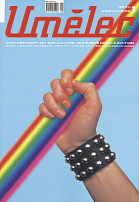| Revista Umělec 2001/1 >> Notes from Switzerland | Lista de todas las ediciones | ||||||||||||
|
|||||||||||||
Notes from SwitzerlandRevista Umělec 2001/101.01.2001 Karel Císař | news | en cs |
|||||||||||||
|
migros museum
Museum für Gegenwartskunst in Zurich was in 1998 renamed “migros museum” after one of the two biggest shopping chains in Switzerland, following Rirkrit Tiravanija’s project to convert it into a supermarket for his exhibition Social Capital. This institution, with a program comparable to that of Le Consortium in Dijon, has recently made public its collections from recent presentations. In addition to confronting the public by blurring the boundaries between art and life, migros’ artists typically collaborate on common projects with colleagues who significantly influenced art in the1990s, which is reflected in the name of the new exposition, Let’s Be Friends. Nobody does this more than Rirkrit Tiravanija, who is represented by his transport installation The Opel Commodore, Joep van Lieshout and his studio, and Douglas Gordon, whose video projections from 1996 work with recordings of rock concerts from the 1960s and 1980s. Hauser & Wirth & Presenhuber Gallery Following participation in the big group shows Intelligence in Tate Britain and What If: Art on the Verge of Architecture and Design in Stockholm’s Moderna Museet, which was concerned with the fusion of contemporary visual art and design, Liam Gillick presented his first solo exhibition at the Zurich-based private gallery Hause & Wirth & Presenhuber. The installation firststepcousinbarprize juxtaposes Gillick’s large frames with colorful mica screens and signs on walls, and draws on what is at times the remarkably brutal language found in 16th century English texts. Their connection creates a space in the boundary between the real and the fictitious, making it impossible to differentiate between abstract and concrete elements. Gillick understood this exhibition as the last stage of preparation for publishing his new book on the re-evaluation of ethics and conscience in the current post-utopian society. Museum für Gegenwartskunst Basel Zurich-based artists Peter Fischli and David Weiss once again expressed their skeptical position in their Basel exhibition, which combined the sculpture of burnt clay, Suddenly This Overview, from 1981 and a new monumental photographic tableau, Visible World, with the slide projection Big Questions — Small Questions, prepared especially for this show. The individual elements of the exhibition — 150 clay dioramas portraying various more or less historical events, 2800 photographic snapshots, and slide projects placed in three separate spaces — provided a different image of today’s world in each case. But their intentionally accidental selection only emphasized the impossibility of exhausting the possibilities. Centre d’Art Contemporain Gavin Turk’s exhibition in Geneva confirmed his continuing interest in exploring what it means to be an artist. This theme may be traced back to his graduation work, which consisted of a memorial plaque reading “Borough of Kensington Gavin Turk Sculptor Worked Here 1989-1991” stuck to the wall of an otherwise bare studio. The Royal College of Art in London refused to give him his diploma for this work. Since then Turk has been assuming various images, of which the best known is the sculpture Pop — a wax figure of Turk dressed up as Sid Vicious posing like Warhol’s Elvis Presley. A similar sculpture in Geneva shows Turk as a run-down homeless person. In addition to this reference to his own work, the exhibition concerns mainly the tension between Duchamp and Warhol. The exhibition opens with a black plastic bag half-filled with garbage, identified as art only after a closer look reveals the fact that it is cast out of bronze. A cardboard box made of the same material represents an unlabelled and open brillo box. Karel Císař
01.01.2001
Artículos recomendados
|
|||||||||||||





Comentarios
Actualmente no hay comentariosAgregar nuevo comentario